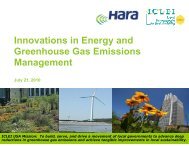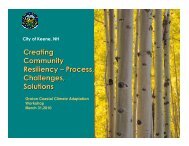Guide to Green Jobs Development - ICLEI Local Governments for ...
Guide to Green Jobs Development - ICLEI Local Governments for ...
Guide to Green Jobs Development - ICLEI Local Governments for ...
You also want an ePaper? Increase the reach of your titles
YUMPU automatically turns print PDFs into web optimized ePapers that Google loves.
Step 7: Develop a <strong>Green</strong> <strong>Jobs</strong> PlanConvene a leadership team. Select a steering committee <strong>to</strong> direct thework of all the organizations involved in the green jobs ef<strong>for</strong>t. If fundingis available, consider whether or not a third party organization canserve as the facilita<strong>to</strong>r of this ef<strong>for</strong>t.Decide the <strong>for</strong>mat of the green jobs plan. Though this can be doneafter a work plan is created, sometimes envisioning the final product atthe outset will help focus the process.• A local government green jobs plan can be a standalone document,a chapter within a general or master plan, a sustainability plan, aclimate action plan, or an economic development plan. Because thisis an emerging area, governments are just now developing greenjobs plans. Currently, many local governments have just developeda series of related ordinances and policies focused on creating greenjobs.Create a work plan. List out all of the tasks of developing the green jobs program. (For a comprehensive list of the tasks involved increating a program and plan, see Table 1).Assign tasks. Divvy up the tasks among the partner organizations involved, and ensure that there is a consistent mechanism (meetings,online reporting, etc) <strong>to</strong> report back the progress of each task.Tools: Assessing the Benefits of <strong>Green</strong> <strong>Jobs</strong> ProgramsQualitative evaluation is an important first step in program and policy development. As many local governments already currentlyemploy a range of <strong>to</strong>ols <strong>to</strong> conduct programmatic analyses, this will not be addressed at length in this guide. Qualitative analysis can beeffectively used <strong>for</strong> the following purposes.Determine basic feasibility and effectiveness of potential job creation plans.Narrow a list of potential measures and programs <strong>to</strong> those that seem most promising.Determine the partners most appropriate <strong>for</strong> managing or undertaking a particular project or program.The next step is <strong>to</strong> provide quantitative evaluation of proposed job creation policies and programs. This crucial ef<strong>for</strong>t will enablestakeholders <strong>to</strong> know the financial benefit from their investments. Some of the <strong>to</strong>ols available <strong>to</strong> local governments will enable them <strong>to</strong>undertake the following analyses.Know the current cost of doing business. The U.S. Department of Labor’s Employment and Training Administration(www.doleta.gov) provides numerous resources <strong>to</strong> assist with such research.• Analyze available government incentives, tax credits, and assistance.• Use real-time in<strong>for</strong>mation about work<strong>for</strong>ce and career in<strong>for</strong>mation, such as local wages and economic trends, industry competencies,and standardized training <strong>to</strong> in<strong>for</strong>m your business decisions.• Estimate recruitment costs and increase retention through work<strong>for</strong>ce solutions, such as screening and referral of job-ready candidates.Translate dollars spent in<strong>to</strong> jobs created. The U.S. DOE has suggested the following rule of thumb <strong>for</strong> the Energy Efficiency andConservation Block Grant: <strong>for</strong> every $92,000 spent on conservation and energy efficiency, one job is created or retained. <strong>Local</strong>governments should utilize more specific or accurate methodologies if they are available.• DOE is currently developing a “job creation” calcula<strong>to</strong>r that will be available at www.icleiusa.org/stimulusfunding when it isreleased.Calculate the co-benefits of energy and GHG emissions savings. <strong>ICLEI</strong>’s Clean Air and Climate Protection (CACP) Software2009 is a one-s<strong>to</strong>p emissions management <strong>to</strong>ol that calculates and tracks emissions and reductions of greenhouse gases (carbon dioxide,methane, nitrous oxide) and criteria air pollutants (NOx, SOx, carbon monoxide, volatile organic compounds, PM10) associatedwith electricity, fuel use, and waste disposal.• CACP 2009 allows governments <strong>to</strong> quantify the associated co-benefits from a broad selection of energy efficiency, renewableenergy, and alternative fuel measures (<strong>to</strong> name a few). As with a climate action plan, CACP 2009 can be used <strong>to</strong> quantifythe energy and financial benefits of particular program proposals. The data produced would include the GHG,energy use and financial savings that you hope <strong>to</strong> achieve from each proposed measure. For more in<strong>for</strong>mation onCACP 2009, visit: www.icleiusa.org/action-center/<strong>to</strong>ols/cacp-softwareUSA8www.icleiusa.org










